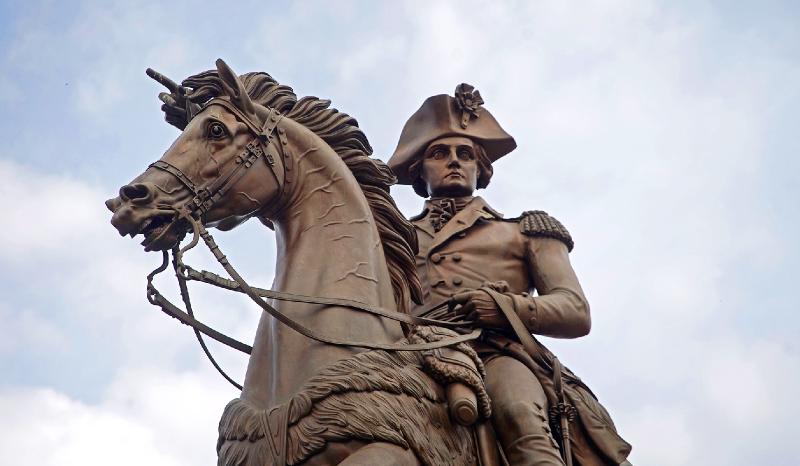Use Nationalism for Good
By: Dan McLaughlin (National Review)



Nationalism, supposedly a relic of the two centuries between the French Revolution and the fall of the Soviet Empire, has proven surprisingly resilient. Should we be alarmed at that? A realistic assessment of human history should tell us that nationalism is one of the fundamental passions of humanity, like self-interest, the drive for power and status, or the sex drive. As with all passions, our goal should be not to eliminate it but to subject it to the constraints of reason and experience.
Fused to those companions, nationalism can be healthy in modest doses. When taken straight, it can be much
more toxic. In the American context, constraint means co-opting nationalism as a component of an informed patriotism that combines the traditional tribal instinct of people, place, and culture with the classical-liberal tradition of the American founding . As Abraham Lincoln wrote in his eulogy for Henry Clay :
He loved his country partly because it was his own country, but mostly because it was a free country; and he burned with a zeal for its advancement, prosperity and glory, because he saw in such, the advancement, prosperity and glory, of human liberty, human right and human nature. He desired the prosperity of his countrymen partly because they were his countrymen, but chiefly to show to the world that freemen could be prosperous.
That sort of patriotism — the preference for one’s own at the level of the nation, leavened with a commitment to internal equality and a preference for spreading the universal example of the American way — is an unalloyed good. The energy of nationalism can and should be harnessed for those good purposes. Trying to suppress it or drive it from the public square is like trying to hold back the tide.
Tribes United
Nationalism is resurgent and controversial in the 2020s, yet even defining it remains a matter of scholarly as well as political dispute. At its simplest level, nationalism is the idea of a people : Some groups of humans see themselves as part of something larger and more cohesive than a random selection of individuals or a narrowly biological family tree. More particularly, it is the distinctive sense that a people and a place belong together in ways that run deeper and have more continuous existence into the future than the accidents of residence.
The existence of a people and its connection to a place are not matters of biological classification or predestiny; they are the byproducts of history. Shared experience creates powerful bonds where none existed before. Individuals and families gain a sense of having been through the same things together. Peoples tend to have other things in common that create stronger bonds of national feeling — kinship, language, religion, music, oral and written traditions — but the sense of having a history together is what makes a people. The fact that this is something believed and felt rather than concrete and tangible does not make it any less real.
The human tendency to band together in groups united by ties of blood, language, and shared culture and history dates back to prehistoric clans and tribes and can be found wherever human beings live in any number. Scholars of nationalism have long debated where and when modern nationalism began, and that debate depends on what you define as nationalism. Is it simply an outgrowth of the ancient bonds of tribalism and loyalty to patria (the ancient Greek and Latin term for “fatherland”)? Or was nationalism a new idea created by the mass popular mobilization of the French Revolution and the advent of mass communications, both of which encouraged ordinary people to identify with a group larger than their own immediate community and clan, and to transfer that allegiance to the national government?
Most of the world’s people, for most of the world’s history, knew and saw little outside their own lands and communities. When George Washington and Napoléon Bonaparte were young men, it was still the case that armies, explorers, and traders could travel no faster than the horse on land or the wind in a sail by sea. Information could move no faster than people. Nothing moved by wire, motor, rail, or air. Light came only from sun and fire. Images were captured only on canvas and stone. These things had all stayed constant since prehistoric man.
National and imperial governments for most of history were typically small in comparison with modern states, even in places where a “private sector” as we now conceive it was nearly nonexistent and most activity was at the mercy of a local head man or patron. Central state structures grew throughout the 17th and 18th centuries, but even the absolute monarchies of the age were far less regularly present in the lives of their subjects than the freest national governments of the 20th and 21st centuries.
Is it possible to look at the social and political structures that existed in the mid 18th century — where people rarely interacted outside their local communities, and largely answered to local rather than central authority — and see the same “nationalism” as the force that bonded people directly to modern nation-states in the two centuries that followed?
Azar Gat, in his 2013 global study of the origins of nationalism Nations , marshaled extensive evidence covering the entire worldwide spectrum of national cultures to argue that the sentiment and language that characterize nationalism could be found virtually everywhere long before the late 18th century. He cited, among many other examples, (1) the practice back to antiquity, across many cultures, of threatened kings successfully invoking patriotic sentiment to rouse their peoples against foreign invaders; (2) the medieval councils of European Catholic bishops, which introduced representation by national origin from the 13th century on and featured extensive arguments disputing which “nations” merited separate recognition; (3) the seventh-century monk Bede’s Ecclesiastical History of the English People , treating the gens anglorum as a single people with a common and distinctive history and culture; (4) the strong national identities of Japan and Korea dating back at least to the Dark Ages; (5) the popular-nationalistic character of the Czech Hussite rebellion of the 15th century; and (6) the long-enduring identity of the Jewish people as a people apart.
One need not buy into Gat’s entire thesis to acknowledge his basic point: The nationalist movements of the late 18th and 19th centuries were not inventing a new idea, but were instead tapping into powerful sentiments with ancient roots in the human psyche and communal experience. The very antiquity of nationalist sentiment should be proof of its enduring roots in human nature itself.
Tribes Mobilized
That said, while academic historians of nationalism debate whether the nationalism of the 19th and 20th centuries was different in kind from the ancient roots of peoples and nations, this much is generally agreed: The national idea became more potent when married to the large-scale popular mobilization of the “nation in arms” that characterized both the armies of the French Revolution and the armies of their foes.
Those mobilizations were enormous. The American Revolution never saw more than around 40,000 men mobilized by either side across all theaters of the war. The 1708 Battle of Oudenarde, by some reckonings the largest battle of the 18th century before 1792, featured a French army of 85,000 men against a joint Anglo–Austrian force of comparable size. By contrast, a new conscription act in France in 1798 raised 400,000 men in one season. The allied force at the 1813 Battle of Leipzig, the largest of the Napoleonic Wars, exceeded 300,000 men, with about 200,000 on the French side. Even Britain, with its traditional disdain for standing armies, expanded the British Army from 40,000 men in 1793 to 250,000 by 1813.
Mobilization runs young men through the homogenizing influence of a national army. The United States, which mobilized the general population of the Union states in the Civil War, did not truly experience mass mobilization across all regions until the First World War, and repeating the experience for a longer war changed us. It had long since changed many of the nations of Europe and Asia. In China, the elite mandarin class was nationalized long before the peasantry by their incorporation in an empire-wide bureaucracy selected by competitive examinations in a common Confucian system of values and writings.
Mass communication and transportation was the second way in which modernity strengthened nationalism in the 19th and 20th centuries. The 1830s and 1840s saw an explosion in newspapers, driven by the steam-powered printing press driving down costs and the railroad and steamships accelerating the speed of news. Photography arrived around the same time, and the telegraph burst on the scene in 1844 and spread with remarkable speed. That era saw, among other things, the breaking down of barriers of local dialect within nations such as France and Spain, and the unifications of Germany and Italy. Later generations saw radio, television, the Internet, social media, and smartphones make it ever easier to break down barriers between localities — but without eliminating the instinct to maintain barriers between nations.
The Six Faces of Nationalism
Another part of the confusion over nationalism is the fact that its character seems different when deployed for different purposes. There are six main ways in which the nationalist spirit manifests itself.
Unifying nationalism , which sets nationalism against localism. The nationalism of George Washington, Alexander Hamilton, Clay, and Lincoln was unifying nationalism, calling people to set aside their local identities and embrace a national identity. So was much of the German and Italian nationalism of the mid 19th century. Battles between nationalists and localists or federalists was a major theme of the middle decades of the 19th century, most notably in the American Civil War and in the civil wars of Mexico and Argentina. This remains an ongoing issue in American, Mexican, Canadian, Italian, Afghan, Iraqi, and to a certain extent Indian and German politics.
Preserving nationalism appeals to the common heritage of a diaspora or a people living under foreign or imperial rule. It is the process that keeps alive the flame of a nation without a state. The Irish and Jewish nationalism of the 19th century, as well as the nationalism of many of the peoples within the Russian, Austrian, and Ottoman empires, mostly assumed the character of preserving nationalism. It was a central theme of the years following the First World War and within the Soviet empire. In today’s world, groups such as the Kurds and Basques seek the solace of preserving nationalism.
Liberating nationalism goes a step further: It rallies a nationality to throw off foreign rule. In the 19th century, anti-French German nationalism, anti-Turkish Greek nationalism, anti-Austrian Italian nationalism, and anti-English Irish nationalism all had the character of liberating nationalism. So did the anti-colonial nationalism of the Americas between 1775 and the 1820s. Liberating nationalism was a major theme of the period from 1918 to 1961, during which a great many new nation-states were formed out of previous imperial or colonial territories. Today’s Palestinian nationalism claims the mantle of liberating nationalism.
Aggressive nationalism is the drive of nations to rule others. The nationalism of Napoleonic France was belligerent and expansionist, seeing the nation’s people and culture as a license and mission to encroach on other nations. The same could be said of American “Manifest Destiny” or late 19th-century European colonialism, and of the nationalist elements of the aggressions of Nazi Germany, Imperial Japan, and Soviet Russia, and the nationalist component of Xi Jinping’s Chinese foreign policy today.
Victorian British colonialism partook of this character at times, although its principal engine was as much liberal as nationalistic, motored by a messianic drive to abolish the global slave trade and spread the blessings of British commerce; the same could be said of much of American foreign policy since 1945.
Exclusionary nationalism is, in a sense, the polar opposite of aggressive nationalism. It spawns the urge to shut foreigners out of one’s country, ranging from anti-trade and anti-immigrant sentiment to resistance to feared foreign sedition, espionage, sabotage, colonialism, and exploitation. In the mid 19th century, prime examples of exclusionary nationalism included the Japanese movement to keep the country closed to foreigners, the American anti-immigrant Know Nothing party, and the Chinese battle against the foreign opium trade. Religious resistance to foreign missionaries has often taken on the character of exclusionary nationalism. The cratering domestic birth rates and fear of migration and global economic competition that characterize the First World countries in the 21st century have driven exclusionary nationalism to center stage in our own time.
Mobilizing nationalism is the force that appeals to citizens to place the greater common good of the nation above their own interest in pursuit of some common goal. We see mobilizing nationalism at work in many areas, whether a military, economic, or public-health emergency. Nineteenth-century nationalism typically observed a mobilizing character only as a component of other forms of nationalism. For example, the Prussian drive to improve the nation’s educational system after Prussia’s 1806 defeats by Napoléon at Jena and Auerstedt was seen mainly as a prelude to restoring Prussia’s military position. The same could be said of the French levée en masse . It became much more common in economic policy in the 20th century. In an age of declining religiosity as a source of human fellowship, many nations have drawn on the well of mobilizing nationalism to ask their citizens to cooperate in efforts against the COVID-19 pandemic.
In short, while nationalism’s potency can make it a dangerous force, particularly in its aggressive form, it is a universal and enduring phenomenon. It is also always a potentially illiberal one; Western liberals have often fooled themselves into believing that unifying, preserving, liberating, or mobilizing nationalism would lead to liberal governance. How we think about nationalism has been viewed differently in different places and times based upon the uses to which it was put. Going forward, a positive program of American nationalism could take a number of different forms that are worthy of debate. But simply denying nationalism’s continuing appeal would be folly. Here, as in other nations, the more the political Left abandons the field of nationalism, the greater will be the political Right’s power to deploy it. The great argument should not be over whether the Right should be nationalist, but how to put nationalism to constructive, patriotic, classically liberal purposes.

DAN MCLAUGHLIN is a senior writer at National Review











The day is coming when the world's population will have doubled again and there will be a struggle for basic resources.
America needs it's sovereignty. Joe Biden is changing the nation's population right now. Do we care about our own future or that of our descendents?
You appear to harbor a penchant for what the author refers to as "exclusionary nationalism" which would deny what America has been and what made her great, a melting pot. You have nothing to fear from immigrants nor migrants, within a generation their children will be as much or more American than you.
You mean LEGAL IMMIGRATION?
You have nothing to fear from immigrants, within a generation their children will be as much or more American than you.
Then let Canada take in the entire third world.
Hasn't worked that way so far. I see it every day here where I live.
It has up here, and I see it every day.
Had Canada's climate been as temperate as America's, I am sure Canada would have been the larger nation by population.
How many are/were illegally there?
How the fuck do I know? Does 'many' work, it seems to be a favorite quantity around here?
Only reason I asked the loaded question is because I am familiar with Canada's migration/immigration policies and it seems that most came up there with the intent of going full blown citizens.
Under Rich Lowry National Review is fullblown fascist.
Really? I'm no fan of Lowry, but he can think for himself.
As for the NR, it's like a breathe of fresh air as the stench from a camp created by 12,000 illegal migrants blows accross the country.
Another shoot the messenger type. SMMFH. This site sure grows their fair share.
The seeded article is completely boring in my opinion.
The issue of nationalism in the US today, is irrevocably tied to race. Many whites have always assumed this was "their" country. The historic evidence for this is overwhelming. But the 21st century is going in a different direction. Panic is in full flight.
As a Reader's Digest synopsis of the forms nationalism can evolve into or from I found it to be of some interest, mostly that it self-exposed the seeder to criticism for xenophobia.
Nationalism is in moderation a great thing. America First is the correct way to look at issues.